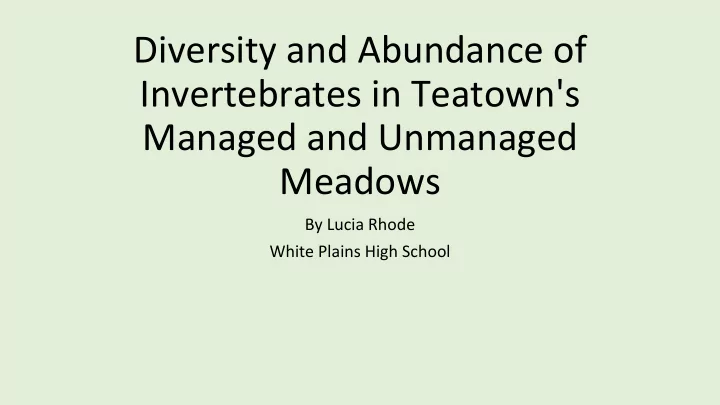

Diversity and Abundance of Invertebrates in Teatown's Managed and Unmanaged Meadows By Lucia Rhode White Plains High School
Introduction • Teatown meadow restoration project • Goal: help increase the bird, insect and small mammal diversity by providing unique habitat space • Maintenance: • Removing shrubs and trees • Regularly mowing • Managing invasive species • Invertebrate may be useful Indicators of condition of Meadows (Hollier et al., 2005; Korosi et al., 2011)
Hypothesis • Invertebrate population of the managed meadow is more diverse and abundant than in the unmanaged meadow
Methodology Pitfall traps • Cup in ground • Soapy water
Methodology Unmanaged Meadow Managed Meadow
Methodology • Collected twice • Pitfall traps collected over 3 nights
Invertebrate Count • Majority of invertebrates are unknown insect • Managed has double the amount of unknown
Invertebrate Count w/o Unknown Insects • Managed Meadow: • Mites • Ants • Spiders • Unmanaged Meadow: • Ants • Orthoptera • Spiders • Isopods
Results • Shannon-Weaver Diversity Index • Managed = 1.65+/-.11 • Unmanaged = 1.38+/-.14 • Managed Meadow had a slightly higher diversity index • Jaccard's Similarity Index • About 70% similar
Discussion • Slight increase in diversity in managed meadow • Ongoing restoration of meadow • Continued long term observation of invertebrate population • Response of insect community to restoration process is usually slow (Karg et al., 2015)
Acknowledgment Thank you to Amy Karpati, Eva Thaddeus, Charlie Luisi and Erin Baker & Teatown References Hollier, J. A., Maczey, N., Masters, G. J., & Mortimer, S. R. (2005). Grassland Leafhoppers (Hemiptera: Auchenorrhyncha) as Indicators of Habitat Condition – A Comparison of between-site and between-year differences in Assemblage Composition. Journal of Insect Conservation, 9 (4), 299-307. doi:10.1007/s10841-005-8821-z Karg, J., Kujawa, K., Manhart, C., Marschalek, H., Neugebauer, K. R., & Sachteleben, J. (2015). Restoration of Subalpine Species-Rich Grasslands: Short-TermvsLong-Term Changes in the Density and Diversity of above- Ground Insects. Polish Journal of Ecology, 63 (1), 142-158. doi:10.3161/15052249pje2015.63.1.013 Kovács- Hostyánszki, A., Kőrösi, Á, Orci, K. M., Batáry, P., & Báldi, A. (2011). Set-aside promotes insect and plant diversity in a Central European country. Agriculture, Ecosystems & Environment,141 (3-4), 296-301. doi:10.1016/j.agee.2011.03.004
Diversity and Abundance of Invertebrates in Teatown's Managed and Unmanaged Meadows By Lucia Rhode White Plains High School
Recommend
More recommend